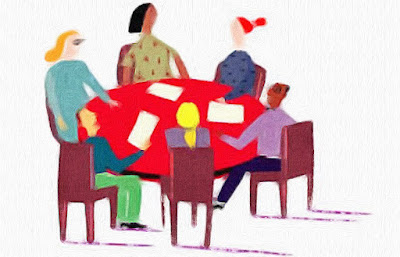Lemon Polenta cake, Scottish shortbreads and Malteser chocolate bunnies: I could get used to hanging out with stroke survivors.
I’m only half joking. This outbreak of gluttony came at the start of the final session in a PhD study by Ella Clark at UCLH into testing Bridges Self Management for stroke survivors in a group setting. We were all stuffing our faces and grinning madly.
Bridges is a project pioneered by Prof Fiona Jones at St George’s hospital in Tooting, London. The mission is to help stroke survivors build their own step programmes to meet long-term goals set by themselves. These goals vary in the widest sense, but the Bridges approach seeks to find a series of baby steps by which big gains can become part of everyday life. It’s a method that will work for some but not always for others.
Motivation is a key player in progressive recovery and these four-week trials were part of a study to see if fellow group members (6-8) could play a role in the process by offering mutual support. In the three trials I helped facilitate, the goals of the group members varied depending on the individual, any support they might or might not have, and in the ways their stroke had impacted on their lives. In the second group I joined, one member wanted to try to regain some of the problem-solving skills he had lost. He mentioned crossword puzzles and arithmetic in particular. Another member defined as a goal writing and signing a Thankyou card for her daughter and her husband.
It is always fascinating to watch small-group dynamics unfold. You instinctively reach for the reality-TV stereotypes and make snap judgements about personalities, only to be confounded in the next session by behaviour in total opposition to your initial prejudice. Baddies become goodies and that bossy boots turns into a pussycat. The relationships between individual characters are thrown into relief and you sometimes end up siding with the person you thought at first you would dislike the most.
Group members respond in different ways to different types of stimuli. One identified her goal as getting back to cooking and entertaining. The stroke had left her unable to plan, organise and implement a dinner party for friends. Fatigue wiped her out and the mere thought of it built in her mind to become an impossible task.
By just talking about food, the group learned of some of her favourite dishes and the special ways she prepared them. All of this took place in the context of a natural conversation, so when it was proposed that she might cook a cake for the group, a competitive twinkle appeared in her eye. She wanted to show us she could do it. And she did. The lemon polenta cake mentioned in the opening paragraph is the proof. The zing of the lemon was a sensory delight.
But her determination didn’t stop there. She had also completed and fed friends with specialty dishes of lamb and salt beef. She was obviously on a roll. If we were giving out marks, she passed with distinction.
A recurring issue among members in all the groups I was involved with was whether the post-stroke difficulties they now face and experience were related directly to the stroke, or whether they were part of natural ageing. Forgetfulness was the chief example. This was especially the case among some of the older group members.
Balancing time with health needs emerged as a another challenge. Take on too much and it might end up costing you in terms of stress and fatigue. Take on too little and it seems like you are treading water, stuck in a rut, but all the time feeling you should be more dynamic, making more progress, just doing things.
One member talked about withdrawing from what was once his very active participation on neighbourhood committees and working groups. He had taken several steps back and, by rationing his time more selectively, was able to focus on and tackle a specialist academic mentoring role, which had proved far more personally rewarding and much better suited to the skills he had built over many years.
But in stepping back he also stepped forward to wrest control of low-key domestic aspects of his life from his children, who had intervened to ensure his comfort. He was calling the shots now and, bit by bit, nurturing a newfound self-reliance.
Towards the end of the final session, one of the group asked Ella if she had a title for the published study that would emerge from these eight group trials. Not yet was her answer, so cheekily I asked the group what might be the key words that would help Ella come up with a successful title.
Earlier in the session that day I had tried to summarise the essence of the past four weeks. In my notebook, I had written “the power/potential of peer support”. Looking at this now I am horrified by its inadequacy. In collecting the thoughts of the other group members, the word that won the day was “sharing”.
Throughout the final session, many of the group had identified in their own ways the importance of sharing. One member spoke of how rare it was for her to share her stroke experience with people who could readily empathise. She said she no longer “felt so alone”. Another talked about how positivity breeds positivity and that the group sessions had somehow almost magically instigated an outbreak of optimism.
Sharing is one of the enduring themes of the early 21st century, much of it enabled by the world wide web. Touch that SHARE button on your digital device and look at the ever-growing number of platforms across which you can connect with others: Facebook, Twitter, Instagram, LinkedIn…
Yet, yet, yet… sharing a traumatic experience with relative strangers is not easily done. The group found that doing it in person, face-to-face, with all the risk any kind of human encounter throws up, was overwhelmingly positive. One group member used the word “transformative” and, when pressed, explained how, as bad as having a stroke is, in some respects it offers an opportunity for renewal, a chance to become a new person. Another talked about life after stroke as an exercise in planting seeds. These, for me, were both fitting remarks to herald the onset of Spring and to end what had for me been a fascinating experience.
See the lemon polenta cake recipe
NeuroBilly
The offmessage thoughts and reports of stroke survivor Billy Mann
Tuesday 9 May 2017
Tuesday 7 February 2017
LSBU: OT Student Society
Billy Mann joins the fun-loving gang of OT students at London Southbank University for their annual conference
 |
| Walk this way |
For my own comfort, I always try to make my contributions to these events simple. I am no expert in brain injury, and neither do I have ambitions to be so. I just tell the story of my stroke and the aftermath in the hope that it fuels questions, which I try to answer as best as I can. I enjoy the process most when I can persuade an expert to join in just in case I panic and start fluffing my lines. My partner at this gig was Headway East London Clinical Lead Amanda D'Souza, who also kindly projected some pictures on to a screen while I ran through my jibber-jabber.
I got some good questions from the LSBU students. They asked me how OTs had contributed to my recovery. They asked about the classic OT-physio tag-team partnership that prevails. I said in my case it worked best as a threesome, OT-physio-patientclientserviceuserorwhatever, where we all fed off each other to advance the therapy. This, I said, could only have happened if we trusted one another. Happily, we did.
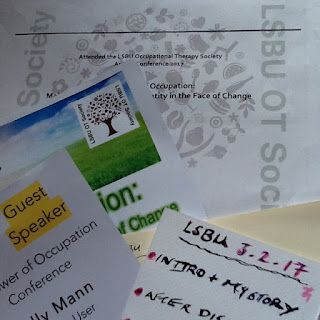 |
| In case I fluffed my lines |
The title of this event was The Power of Occupation, its subtitle "maintaining professional identity in the face of change". I detected from this and from some of the questions that all was not happy in the land of OT, that they were feeling neglected and undervalued as professionals.
This was not exactly a shock to me, but from the impressive display of organisation and attendance I was seeing today, I was surprised the LSBU students were struggling for status and recognition. It seemed to me like they were at the top of their game, and embracing it all with relish. Four years earlier, when I was in the neuro-rehab unit at the National Hospital for Neurology and Neurosurgery (NHNN) in Queen Square, London, my OT had told me that Occupational Therapy was misunderstood and its therapists unsure of their identity within the nhs. OT is a broad church, covering a large area from behavioural OT to hardline neuro. I mused to the LSBU students that one day new names for jobs might need to be invented. I don't think this offered them any comfort, and nor did my pronouncement that after a conversation one day with Headway East London OT Natasha Lockyer, I had come to define OT as a subspecies of Anthropology or Ethnography. I saw it as "the science of how we do things".
I had started my talk by telling the students that earlier in the day I had bumped into a neighbour, a head teacher at a special needs school, and told her that later I would be talking to OT students. "Ohh, I love OTs," she said, "and they make the best managers ever." This was a positive start and I'd tried to find a catchy soundbite to finish my talk, but as the endpoint neared, "Everyday OT is the key" started to sound flimsy, so I told them how my wife uses OT to get me to do chores. When she wants me to do things like set the dining table or empty the washing machine, she finishes her request with "It's good OT". I have a feeling she could be right about that.
Tuesday 24 January 2017
Trust World Café: stroke care
An initiative to put good communication at the heart of stroke treatment got off to a lively start. Billy Mann reports.
Tess Baird is an unstoppable force. In November 2016 she gathered together a few colleagues and contacts in a small room in London's Mile End Hospital to explain her bonkers idea. She wanted clinicians and service users to get to understand and communicate with one another in more meaningful and effective ways. The subject in focus was stroke care, which is how I got the call, being a stroke survivor. She reckoned this new groundbreaking bond between patient and practitioner could be found using something called a World Café. I posted a report of that meeting shortly after it took place.
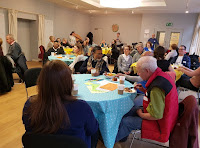 |
| Table talk |
Seven round tables in the Garden Room at St Luke's Community Centre, London EC1, each hosting five or six people, fired up and the room quickly took on the buzz of the marketplace, the sound of chatter and earnest declarations bouncing off the walls. Hot beverages were taken and posh cake digested. And to think some people were pretending to 'be at work'.
 |
| Question 1 |
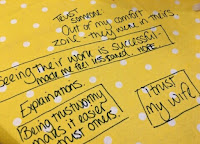 |
| Cloth ears |
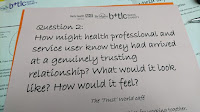 |
| Question 2 |
The questions continued. We moved tables, went into huddles, struggled to find answers, but didn't give up. There was still plenty of cake left. At one table I put forward the idea that every 'hard', factual question a patient is asked by a clinician should be offset with a 'soft' question that gently explores the patient's life outside hospital. Cat or dog? was the example I used in a round-the-table demonstration (our table: three dogs, one cat and an awkward "cat and dog"). Questions about football, hobbies, telly, films, etc, can provide the therapist with valuable 'clues' that might open a window of opportunity on how best to advance treatment. There was some concern as to how what is essentially small-talk can be parlayed into 'productivity', the looming presence of a cash-conscious clipboarding nhs manager being the sticking point. I'm not sure my attempt to liken this kind of information-gathering to 'detective work' found any buyers.
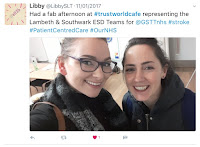 |
| Libby and Aoiffe |
Monday 16 January 2017
Lightbulb moment: Freewheelers Day
Politicians, celebrities ... you might think you know all about disability. You can obviously talk the talk. But where do you finish when the chips are down, asks stroke survivor Billy Mann
Just before Christmas 2016 my wife and a friend took part in a 5k Santa Run in aid of Headway East London, where I have been a member for 3 years following a stroke. It was a fantastic day, full of goodwill and festive fun, staged in London's Victoria Park. Families gathered to watch the would-be 'Olympians' struggle into their allotted Santa suits and run/walk/stagger/jog around a pre-determined route and finish out of breath but with a warm glow. Medals awaited their sweaty necks. |
| A winner's medal awaited everyone |
Another positive on this briskly cold day was the event coordination and management. There was an orderly queue to collect your daft Santa outfit (which you get to keep). A sound system pumped out hard-rocking running anthems and victory songs. Food and drink stalls kept the spectators (some courageously dressed as Elves) sustained. But top prize goes to the toilets, vintage white plastic boxes that sealed the whole occasion as being more like a music festival than anything else.
So it isn't hard to imagine the potential of all this combined effort, and one of the bees in my bonnet ever since leaving hospital after my stroke was the difficulties faced by wheelchair users and the attitudes of their busy able-bodied fellow citizens, issues exposed by Channel 4 during the 2012 London Olympics/Paralympics. Boris Johnson was still Mayor of London at the time and my favourite imagined punishment for him for not dealing with this was an initiative in which he was forced by public pressure to use a wheelchair for one working day in every year. This, I felt, might bounce him into action.
Now I have a better plan. One day in every year should be designated Freewheelers Day. On this day, the leaders of political parties, councils, big organisations and anyone else you can think of, race each other around a flat designated circuit such as the one in London's Victoria Park (there are such spaces all over Britain). Others can follow behind in their wheelchairs or with pushchairs, their friends and families cheering all the way with scalding hot cups of Bovril in their hands. Watch as Theresa May and Jeremy Corbyn try to viciously crash each other off the track. Hotshot celebrities such as Jeremy Clarkson could go wheel to wheel with, say, Steve Coogan. Bring it on. The sound system will explode to the sound of Bat Out Of Hell and Born To Run, and from that day on until the same time next year, everyone will show a bit more understanding for the other person.
 |
| Are today's leaders match-fit for dealing with disability? |
Thursday 22 December 2016
My Stroke Journey
Art gave Billy Mann a chance to tell the story of his stroke in an unusual and often graphic way
My annual visit to the National Hospital of Neurology and Neurosurgery in Queen Square, London, to deliver some macaroons and Vin Santo to the therapy team for Christmas, got me feeling sentimental. I realised that visiting the Neuro Rehabilitation Unit (NRU) on the second floor has become like returning to your old school. Memories come flooding back. Seeing the patients travelling the same rocky road I did four years ago is a wrench, riddled with pain but saved by an overwhelming sense of hope. So much happened here for me. It is where my life was put back together. It was a rebirth. So, as naff as that sounds, I feel quite attached to the place and to the people who helped me during my two-month stay.
Most of them have moved on, but Anne Fleming, who dealt with social work issues, was still there and full of good spirit and a still unfeasibly straight fringe. I deposited the festive goodies with her, asked her to pass on my best wishes to anyone who might remember me and put in a plug for an exhibition of paintings by survivors of brain injury from Headway East London art studio, Submit To Love.
It wasn't such a shameless plug since I have a series of five paintings included in the exhibition depicting my 'stroke journey', and as already stated, NRU played a key part in that. Each of my paintings includes a hand-written paragraph describing the five 'chapters' of the past four years, from the moment of the stroke to my life as it is today.
The first, 'Surrender' attempts to illustrate the period from the initial trauma to when I went into surgery.
Surrender
The second picture, 'Oblivion', is all about what happened in surgery.
Oblivion
The third, 'Confusion', examines what happened after surgery when I was in and out of ITU and then on the stroke ward.
Confusion
The fourth painting in the series, 'Survival', covers the sink-or-swim experience of my stay in NRU, where the chance to start again kicks into action.
Survival
And the final picture, 'Release', reflects of my life since discharge from hospital in February 2013 and the shape it has taken since then.
Release
I could bang on endlessly about these pictures and their meaning, but the blunt truth is that, once they were finished, I was glad to see the back of them. I was bored with myself, and right now I don't care if I never see them again. Sometimes the right thing to do is to simply let go of what was and what happened. Strange, though, I can't imagine losing the tiny bit of love I feel whenever I visit the National Hospital in Queen Square, and long may the macaroons continue to be delivered.
The exhibition of paintings by members of Headway East London is at Stratford Circus Arts Centre, London, until 23 February 2017.
Saturday 12 November 2016
It is good to talk: conversation in practice
The first patient-clinician interview is the chance to start a beautiful partnership, says Billy Mann
Hold that thought while I tell you about a group I attended recently to work through the foundations of what will hopefully turn into a World Café around the subject of stroke. Briefly, the idea is to build the notion of a ‘conversation’ into the clinician/patient meeting point. Those present at the meeting, brought together by Tess Baird from Barts Health, all came from the health professions or from academia. Plus me, with my A-level in Geology and a diploma in stroke survival.
So it goes without saying that my input was purely anecdotal. I told them all how, during stroke rehab, I stupidly urged an OT to coach me in getting in and out of the bath, only then to get stuck in the bath, robbed, as the stroke had left me, of the upper-body strength to lift myself into a bath-exiting position. I told other hilarious stroke stories, too, and watched as they all glazed over, but my one serious point concerned what I called the ‘partnership’ a patient needs to form with the health professionals charged with their care.
I decided early in the exploration of my post-stroke world to ‘get people onside’. OK, confession, my wife told me to do it, in fairly blunt and unambiguous terms. But it worked, or at least it did for me. I talked in a friendly way to all professionals. I listened to their gripes. I learned that my physio was studying for a masters degree. I gossiped for Britain and passed on advice for vegetarians travelling in Italy. All of this seemed to bind our common purpose in a more meaningful and, yes, fun way. My wife now refers to me as a 'people person'.
I continued this crazy experiment once I had been discharged from hospital. First on the list for my newfound charm offensive was my GP. I learned about his family, about his specialist areas of medicine and tried to get him to bitch about bureaucracy and the tedium of top-down meddling in the nhs. He didn't crack, maintaining a steely resolve throughout. No confidential or compromising disclosures took place, but the very act of talking made, and continues to make, a difference to how we ‘work together’.
Others in the group made serious points, too. Physiotherapist Volkmar Müller talked about the everyday realities of the physio’s job and how ‘had nice a chat with X’ would not be considered by his line manager as a suitable entry on that day's list of ‘work completed’. Stefan Cantore, a seasoned egghead in organisational behaviour at Southampton University, fleshed out the World Café philosophy and its potential. He also helpfully (for me) clarified the difference between conversation and dialogue.
The small room in Mile End hospital fizzed with the desire to find practical routes towards better communication, but one theme emerged persistently: TRUST. Build trust. Professionals to trust patients; patients to trust professionals. It’s a two-way thing and demands active participation and a big old willingness to give it a go. And this is where we come back to THE CONVERSATION.
Just for a laugh, I decided to do a quick search of synonyms for the word ‘conversation’. Top prizes go to: tête-à-tête, heart-to-heart, breaking bread, head-to-head, shoot the breeze, natter, confab, chit-chat, rabbit. In my head it's already starting to sound like two lines in a rap song, but whatever you want to call it, just get on with doing it, and at some point in the future maybe we will be able to state with confidence that to Talk The Talk and to Walk The Walk are exactly the same thing.
Just for a laugh, I decided to do a quick search of synonyms for the word ‘conversation’. Top prizes go to: tête-à-tête, heart-to-heart, breaking bread, head-to-head, shoot the breeze, natter, confab, chit-chat, rabbit. In my head it's already starting to sound like two lines in a rap song, but whatever you want to call it, just get on with doing it, and at some point in the future maybe we will be able to state with confidence that to Talk The Talk and to Walk The Walk are exactly the same thing.
Wednesday 6 July 2016
Wet, wet, wet
 You might have sat comfortably during the 2012 Olympics and gazed at the pictures on your telly of the Zaha Hadid-designed London Aquatics Centre and wondered whether it was as impressive in real life as it was as seen through the lens of a TV camera. Let me answer that question. Yes. Yes. Yes.
You might have sat comfortably during the 2012 Olympics and gazed at the pictures on your telly of the Zaha Hadid-designed London Aquatics Centre and wondered whether it was as impressive in real life as it was as seen through the lens of a TV camera. Let me answer that question. Yes. Yes. Yes.
And it’s not just a stunner on the outside. Despite the modifications that took place before its 2014 opening to the public, the huge interior is a dream just to walk around, even before your nose catches a whiff of chlorine. The views of the 50m tournament race pool and 25m diving pool recall instantly memories of the moments that took your breath away during those glory days in the summer of 2012 (was this when Michael Phelps officially became ‘the greatest swimmer that ever lived?). The overall effect is somehow magic, and even the signs to the changing rooms start to look full of grace, visual harmony and touched by the hand of triumph.
Now, here we were, a willing contingent from Headway East London, itching to see if getting wet could do anything for brain injury.
My own post-injury experience in the shallow end is meaningful - to me at least. Shortly after discharge from hospital following a hemorrhagic stroke, I was assigned to a therapy team from London's Homerton hospital. A physio and OT visited me at home and devised various exercises and routines that might aid my recovery. On one such visit we went for a swim in my local pool. The OT was at first concerned how I would manage getting in and out of the pool. Her worry was short-lived as I pre-empted any practical what-have-you by simply throwing myself in.
Hitting the water and being bathed instantly in its warm, forgiving embrace was a moment of sensuality words cannot do justice to. Four months of deprivation in a hospital bed might well be the psychologist's explanation, but ‘bliss’ is as close as I can get to describe the sublime feeling.
I'd like to say that in that single moment swimming became an essential post-stroke exercise for me. That would be a lie. But what I did find on our group visit to the Aquatics Centre, in between some infantile splashing of my fellow Headway members, was a new way to use a swimming pool. Some of the yoga and tai-chi routines that Headway Therapy Team offers regularly to its members are given a whole new dimension when tried in a pool. The soft resistance of the water slows the movements and provides weight support for those with balance problems. Falling over in a swimming pool is no biggie. It's fun, actually.
So, expect to see me in swimming pools more often from now on. The legacy of London 2012 is alive and kicking, despite all those doomy predictions. It was shortly after attending events at the Games that the stroke hit, leaving me for dead. I can’t be sure, but I like think that the courage, determination and sheer strength of will I saw in the athletes helped things turn out differently for me, so if anyone ever tells you those Games were a waste of money, tie a brick to their foot and throw them in the deep end.
Subscribe to:
Posts (Atom)






